Surprise, pals! My debut was an upload of my million and one emotions, ideas, and dreams about Chandra, Nissa, and LGBTQ rep in Magic, and after some talk with the Hipsters team we’ve decided it was also the first article of a new column about Magic lore, storytelling, and Vorthos life generally, specifically through a lens that is gay, trans, and female. Welcome to Prismatic Vista.
I’m a hardcore Vorthos (what’s Vorthos? my fellow filthy casuals may be asking, and I am here to give them the answer). I’m a Vorthos not in the sense that “oh the lore is cool, I like reading the stories”, I’m a Vorthos in the sense that I can’t rank up in Arena because I won’t play decks that don’t center around my favorite legendary character of the week. What would be the point of winning if I’m not winning as one of my faves?
As a proud Nissa stan, during the previews for ONE I was all about one card in particular: Nissa, Ascended Animist. When the set came out, I immediately went on Arena and traded a few mythic rare proxies. And I love this card. I’m pretty sure it’s a good card, too. But this article is about why I love it, other than the fact that it wins me games sometimes.

The thing is, there’s something about the moment that first 8/8 token comes into play when I feel like Nissa at the head of an army of elementals. When I take out the enchantment at the heart of an opponent’s combo, I feel like Nissa harnessing her primal power to overwhelm ancient magic (with, naturally, a destructive Phyrexian twist). When I have Ascended Animist in play, I almost feel like I’m playing D&D (or one of my preferred alternatives), like I’m playing a character. And that’s the feeling I most often chase when I’m playing Magic, not the satisfaction of winning a game or landing a combo.
But (and this is the key thing) the mechanics are very important to what I’m talking about. The pleasures of playing a card with a pretty picture, cool flavor text, or that represents a character I love are real and wonderful, but that’s not all I’m talking about here. It’s specifically the game giving me the feeling that I know what it would be like to have the amazing abilities – or perhaps the heroic character – of the legends I am playing. This isn’t a new idea – Mark Rosewater referred to this idea in his classic article on the Vorthos archetype (“You’ve become a dragon. You… are a dragon!”) – but it’s a specific flavor of Vorthos that I think gets lost sometimes.
Today I’m going to take a look at a few other memorable cards from the last few years and rate them, not for efficiency or their suitability in Limited or Constructed play, but for this quality that I’m going to call “roleplay potential” – the degree to which the card allows you to feel, for a moment, like you are the character that the card represents, or at least that you have that character at your side.
This is not a judgment, needless to say, of whether these cards are “good”, or even of whether they’re “cool.” Spoiler alert, one of my favorite cards from 2022 is on this list, and it’s rating isn’t all that good! We’re looking at these cards through the very, very narrow lens of roleplay potential.
Lord Xander, the Collector
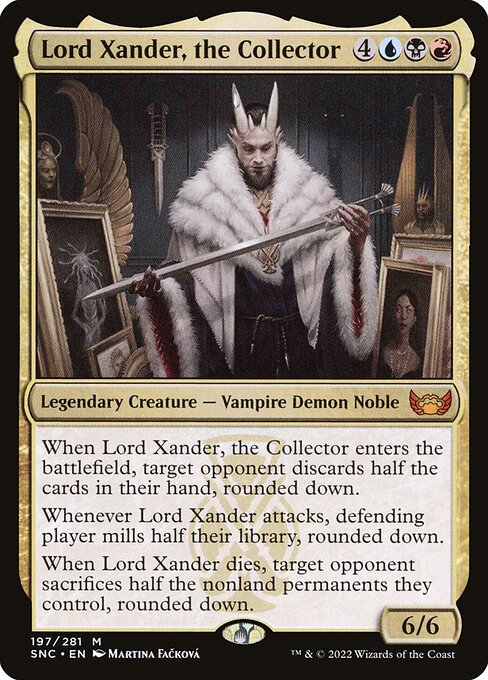
Lord Xander is Elspeth’s not-completely-trustworthy ally on New Capenna, and a tie to the plane’s murky origins. Secretive, cynical, and brilliant, Xander sees further ahead than most of the other family heads, but Ob Nixilis still gets the best of him in the end.
Lord Xander, The Collector is carefully designed to reflect the themes of Xander’s character. Immortal after a demonic contract, time has left gaping holes in his memories of his early life that torment him, holes that he desperately seeks to fill by gathering all the knowledge he can about New Capenna’s history.
The card’s ability inflicts Xander’s ailment of failing memory on his opponents, wiping out a planeswalker’s metaphorical mental resources. It’s a thoughtful and evocative Vorthos design – but in terms of roleplay potential as I’ve defined it, it’s not so hot. The card communicates the themes of Xander’s story, but doesn’t capture the experience of being him at all. Xander’s power is the slow, careful accumulation of knowledge leading to the perfect intervention at the perfect moment, not a sudden cascade of lost knowledge. The card does represent Xander, but it doesn’t let you be Xander.
Roleplay Potential: 1 out of 5 Ascended Animists.
Elspeth Resplendent
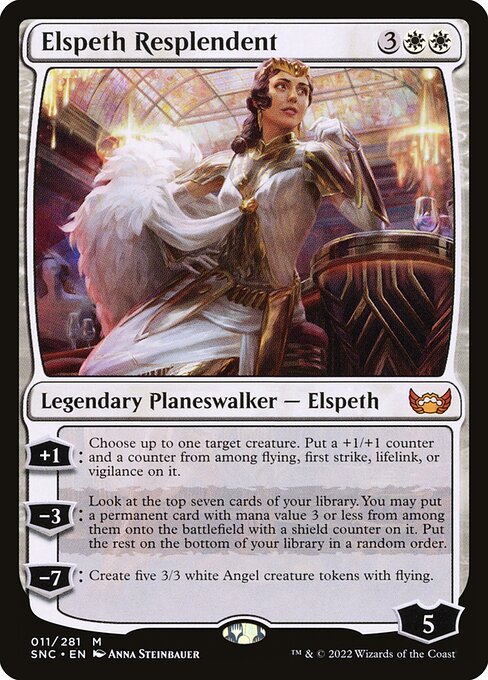
I chose poor Elspeth to demonstrate that not all planeswalkers are slam dunks for reoleplay potential. Let me be clear: as a Vorthos, I love this card. I mean, the art alone! But the mechanics of Elspeth Resplendent are all about summoning and buffing creatures, and we never actually see Elspeth doing that in New Capenna. Elspeth does have leadership in her history, but she’s operated more as a warrior than a commander for a long time, and in this storyline we see her as an independent operator.
Buffing does feel generally right for Elspeth, because she does have a way of inspiring and elevating her allies – notably, in the New Capenna storyline, Giada. But in terms of what she actually does and how she uses her magic in New Capenna, this card just doesn’t really capture it.
Roleplay Potential: 2 out of 5 Ascended Animists
Innocent Traveler

Roleplay potential isn’t just for Legends. Innocent Traveler is an intriguing card because it tells such a clear story. A beautiful woman knocks on your door late at night, and she seems harmless, so of course you invite her in. When people start disappearing, eventually you band together for safety and stop letting anyone else wander alone to their deaths. Only then does she reveal her true, dangerous form.
However, Innocent Traveler gets dinged because it’s not really powerful enough to affect the state of the board in the way that underlying story would suggest; that is, you’re not likely to actually live out the scenario its mechanics suggest. In my experience most opponents just let Innocent Traveler transform unless they have a token sitting around doing nothing, because they’d rather face a flier than give up their own creatures.
This brings up an important point: to have roleplay potential, a card has to reliably do something. A beautiful concept isn’t enough.
Roleplay Potential: 2.5 out of 5 Ascended Animists.
Olivia, Crimson Bride
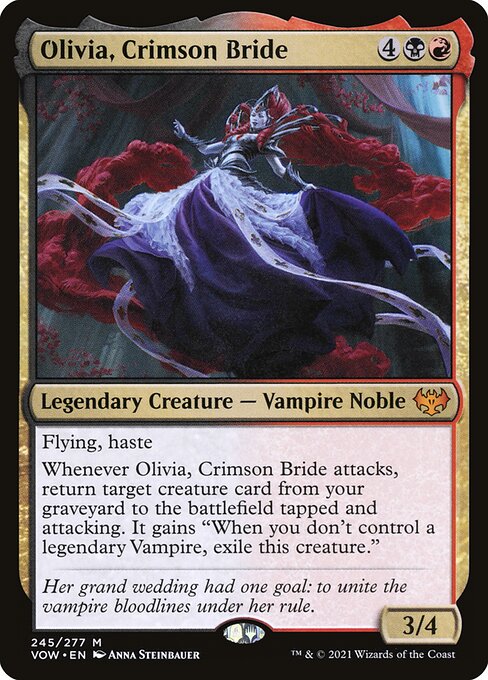
Olivia Voldaren is cool personified, a classic mean girl, Regina George with sharp teeth. She’s gorgeous, she’s rich, she’s domineering, and everyone is terrified of her. This card totally captures some of that; the combination of flying and haste lets you be aggressive. And that plus the potential appearance of another creature from your graveyard on the same turn Olivia is played communicates some of the shock and awe that Olivia’s opponents would surely feel facing off with her.
But Olivia, Crimson Bride loses me by involving the graveyard. Yes, Liv does initiate the plot of the Crimson Vow set by awakening a legendary vampire from a deathlike state, and yes, of course it’s very thematic for an Innistrad set broadly. But Olivia doesn’t go turning every Thalia, Dennick, and Jacob into a vampire (exclusivity is her whole thing), nor would she condescend to go crawling around dead bodies (she has people for that). Olivia is a hot rich girl, not some pasty necromancer, Gisa.
I’d prefer a mechanic that emphasizes how compellingly seductive (and intimidating) she is, or her army of sycophants.
Roleplay Potential: 3 out of 5 Ascended Animists.
Norika Yamazaki, the Poet
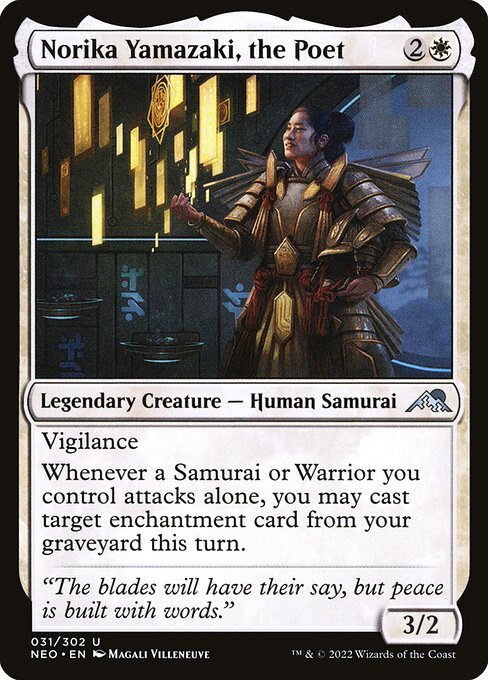
Norika is the star, along with her cousin Heiko, of a real hidden gem of a Magic story from last year, “The Foes Who Make Us”. Newly assigned as the imperial administrator of rebellious Sokenzen, the thoughtful, self-possessed Norika reunites with Heiko and begins the process of negotiating peace with the local rebels.
Norika Yamazaki, the Poet really works for me, even though the mechanic doesn’t tell her story literally. Norika is a calm, graceful, dignified presence, and “Foes” tells us that she’s recovered from loss before. And though I took the graveyard very literally for Olivia, Crimson Bride, I’m going to let this card use it symbolically. If the hand is the top of a planeswalker’s mind, and the deck is the whole of their knowledge and experience, then the vibes of grounded, meditative Norika Yamazaki letting them recover something – especially something slow and stable like an enchantment – works pretty well.
This card doesn’t exactly capture the experience of being Norika, but it captures what Heiko feels being around Norika in “Foes”: Norika helps you touch parts of yourself you hardly knew were missing, and heal wounds you hardly knew you had. I’m rating this card relatively low because it relies so much on vibes and what feels right rather than a straightforward representation of what Norika actually does, but it’s definitely a favorite of mine.
Roleplay Potential: 3.5 out of 5 Ascended Animists.
Tori D’Avenenant, Fury Rider
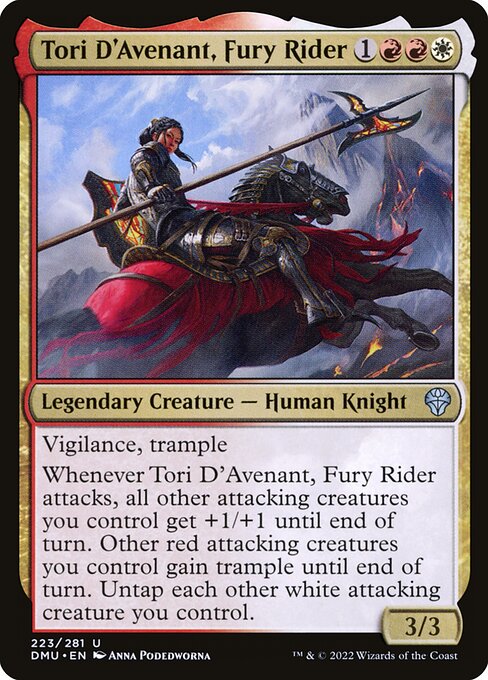
Tori is tragically excluded from any official Magic fiction (attn: fanfic writers), so all we know about her is a little blurb from Dominaria United promo materials. She’s disabled but hasn’t let it stop her from becoming a master cavalry officer, which is pretty cool to start, and to be honest, I didn’t need to know even that to know that I would follow her anywhere. What can I say, I’m gay and when a lady pulls up on a horse and says “charge that position with me, I will give you a +1/+1 til end of turn and effectively grant you vigilance,” I awkwardly blurt “I’m seeing someone.”
Seriously: Tori is a dashing knight who grants big bonuses to other attacking creatures. The story told by the card is as subtle as a cavalry charge, and perfectly expressed.
Like Innocent Traveler, Tori suffers a little because in my experience, it’s a little difficult to actually get in a position to use her to full effect; she’s relatively expensive and you need time to build up a force worthy of her leadership, plus she’s a favored target for creature removal.
But if you get there, it’s a cinematic moment worthy of Peter Jackson.
Roleplay Potential: 4 out of 5 Ascended Animists.
Jace, the Perfected Mind
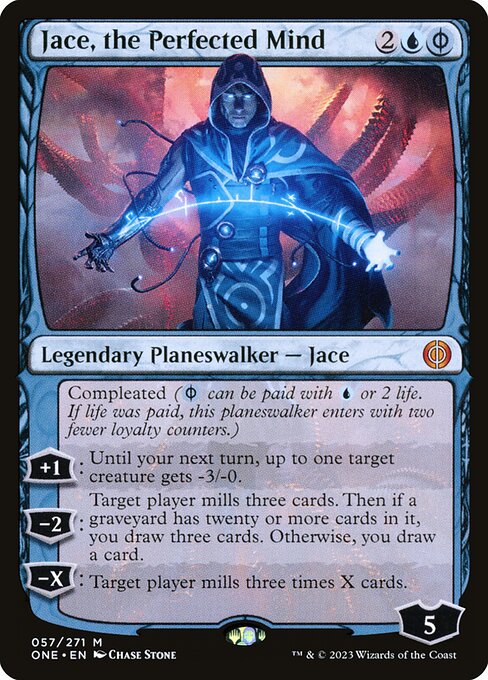
I’ll be honest: going through this exercise, I think it’s just easier to achieve peak roleplay potential with planeswalkers than any other card type, because they’re powerful, they have an effect very quickly, and they have multiple abilities to capture multiple aspects of a character. It’s not an accident that a planeswalker was my first example of a card with amazing roleplay potential and another planeswalker is my second example.
But come on: it’s perfect. Imagine going up against Jace; his illusions make him hard to attack, and his telepathic attacks chip away at your mental state while his own mana-fuelled mind is working faster and faster as the fight goes on. Finally, when he’s ready, he just starts smashing things in your head until you’re done.
It’s terrifying, and incidentally it’s a great Phyrexian counterpoint to Jace’s last appearance as Jace, Mirror Mage (which focused much more on his ability to think quickly by giving you scrying and drawing options). The Jace we knew was always careful with his potentially invasive and destructive powers; compleated Jace has left those concerns far behind.
Roleplay Potential: 5 out of 5 Ascended Animists.
Those are the rankings, for today! The concept of roleplay potential is obviously subjective, so your mileage may vary in what cards you connect to. But I hope I’ve given you an interesting new way to think about Magic from a Vorthos perspective.
Dora Rogers (she/her) is a writer, game designer, and heart-eyes lesbo from Montreal. She is one half of Gal Pal Games, and you can find her solo TTRPG and interactive fiction projects on itch.io. Follow her in all the places, or catch her on Arena playing questionable Vorthos decks in Standard.

